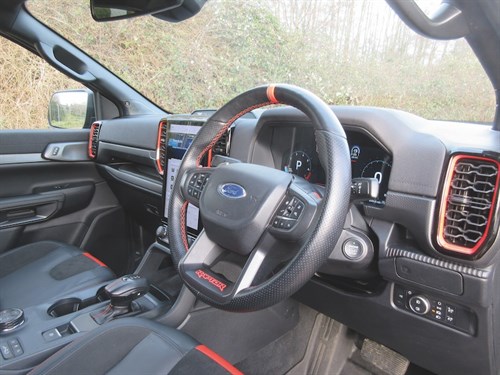- Arval research uncovers van fleet optimism
- Pre-orders open for new Nissan Interstar
- More than half of UK van drivers now believe EVs more cost effective than ICE, VW finds
- Public EV charging costs preventing adoption for some fleets, AFP says
- Ford Ranger Tremor review
- Inseego awarded Crown Commercial Service framework status
- ADVERTISEMENT FEATURE: Electrify and optimise: Digital solutions at the forefront of decarbonisation
- Fleets being pushed to take electric vans due to ZEV mandate, AFP reports
- Buying a used... Citroen Relay (2019)
- Fleetfind joins Fleetcheck affinity programme
The What Van? Road Test: Ford Ranger Raptor
Date: Tuesday, April 16, 2024

Interior and equipment
Leather-trimmed seats with orange stitching and inserts and a ‘Baja’ logo come as part of the deal, and we love the big 12in touch-screen that dominates the centre of the dashboard.
Unlike so many screens of its type, it is easy to use, and even a technological dinosaur like the writer can master it in a few short minutes. It is a model of clarity, and we like the idea of using it to access the owner’s manual digitally.
That said, we’re nonetheless pleased to see that a separate set of knobs is used to control the heating, ventilation and air-conditioning system.
The screen controls the DAB radio – the 10-speaker Bang & Olufsen stereo system is little short of excellent - and the satellite navigation system. Other features include wireless Android Auto and Apple CarPlay connectivity, and there’s a handy smartphone dock at the bottom of the dashboard with USB sockets.
The seemingly-endless selection of onboard kit includes keyless starting; an electric parking brake; front and rear parking sensors; electric windows; a heated windscreen; power-operated adjustable exterior rear-view mirrors which fold in electrically, and driver, front passenger and side airbags.
Front- and rear-view cameras aid low-speed manoeuvring, and offer the ability to see how close individual corners of the vehicle are to obstructions. The system provides a birds-eye view of everything surrounding Raptor too.
The heated front seats are remarkably comfortable, providing ample support in all the right places. The height of the heated, leather-trimmed, steering wheel can be altered as can the height of the driver’s seat, which boasts ten-way electric adjustment. So does the front passenger seat.
In-cab storage facilities include a lidded and lockable glovebox with a shelf above it, bins in the doors, and a lidded compartment between the front seats with a tray just under the lid. The compartment conceals a 12v power point. The console between the seats plays host to a pair of cup-holders and you will find a slot for your sunglasses just above the windscreen.
Turning to the three seats in the back, the passengers closest to the doors get to enjoy a reasonable amount of legroom. Space for the middle passenger is restricted however, and the centre seat is likely to be somewhat uncomfortable on a long journey.
At least it has the advantage that the middle section of the seat back can be pulled down if the seat is unoccupied and turned into a table for the other rear passengers to use.
Items they can all use are the 230V power socket and the USB ports in the back of the console between the front seats.
Every time we stopped and switched the engine off a warning came up on the touch-screen advising us to check for the presence of rear passengers. We always did - but nobody was there.
Maybe it’s a safety or security measure. Spooky all the same.
Onboard driver assistance and safety systems include ABS, Electronic Stability Control, and Roll Stability Control. Traction Control System is fitted, and can be switched off.
Provided too are Active Park Assist, Adaptive Cruise Control with Lane Centring, Collision Mitigation System and Hill Descent Control. The Blind Spot monitoring system takes the presence of any trailer being towed into account and our truck came with an integrated trailer brake controller.
Our demonstrator’s 17in black alloy wheels were shod with BFGoodrich All-Terrain T/A KO2 285/70 R17 tyres. A pressure monitoring system keeps an eye on their health.
View The WhatVan Digital Edition


